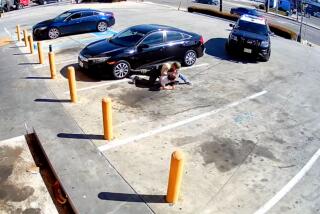L.A. County jail guard charged with assault for looking the other way while inmates beat someone up

The case against Custody Assistant Jonathan Grijalva is the latest in a string of criminal prosecutions that have roiled the Los Angeles County Sheriff’s Department
- Share via
The inmate said he was summoned to a spot under a stairway where no jail guards or cameras would be able to see.
There, he said, three other Los Angeles County inmates ambushed him, leaving him with a busted jaw and broken nose, a concussion, double vision and blood oozing from his face.
The inmate, Saul Steve Lira, said the guard on duty deliberately ignored what was going on.
Now, prosecutors have charged the guard with assault, accusing him of walking away at the request of another inmate so Lira could be beaten and later refusing to assist Lira with medical help.
The case against Custody Assistant Jonathan Grijalva is the latest in a string of criminal prosecutions that have roiled the Los Angeles County Sheriff’s Department since a jail scandal involving beatings of inmates erupted more than five years ago.
But the charge marks the first time since then that a guard has been accused of looking the other way to allow inmates to attack someone else.
Jail experts said the Sheriff’s Department has made significant progress in reducing serious force in the jails but that Grijalva’s case raises ongoing concerns about whether inmates feel safe enough to come forward with complaints about brutality or other jailer misconduct.
Soon after the Feb. 15, 2014, incident, Lira reported that his injuries were caused by a fall in the shower, not by an assault. Despite the seriousness of his injuries, no one at the jail appears to have questioned his initial account. The department didn’t launch an investigation for another two months — after Lira obtained a lawyer and detailed in a legal complaint against the county that he had been assaulted, a department spokeswoman said. He later said in a lawsuit that he lied because he feared retaliation by the inmates.
Peter Eliasberg, legal director of the American Civil Liberties Union of Southern California, which is a court-ordered monitor of the jails, said figuring out the cause of inmate injuries is a key part of developing accountability.
Jail staff, he said, must look for signs that inmates are holding back out of fear for their safety and the department needs to do more to change the culture so that inmates feel comfortable speaking up about violence.
“There are ways to get reluctant witnesses to speak, but you have to make sure they don’t feel they’re going to be tagged as a snitch,” he said. “It concerns me that there wasn’t a thorough investigation until the inmate filed a civil rights claim.”
Sheriff’s officials said they took Lira’s allegations seriously as soon as they learned of them and have taken aggressive steps to prevent similar episodes in the future.
“Maintaining public trust and confidence in the management of our jail system is highly important to me,” Sheriff Jim McDonnell said in a statement.
The department has added cameras throughout its jails, including the North County Correctional Facility, where Lira was held. Since June, 100 cameras have been installed in the Castaic jail and officials plan to add 600 more, said sheriff’s spokeswoman Nicole Nishida.
Chief David Fender, who helps run the department’s Custody Services Division, said sergeants are now required to interview inmates to figure out how they received their injuries in case they were from a beating.
“It is a different world today than it was in 2011 when a lot of this jail violence was coming to a head,” Fender said. “People are held accountable at a much higher level than they were before.”
Grijalva, a 28-year-old custody assistant who has worked for the department since he was 19, was charged in November. He’s been on unpaid leave since October 2014. Prosecutors also filed an assault charge against Raul McDonald, an inmate accused of standing guard so that Lira could be beaten without interference.
Both have pleaded not guilty.
This just shows you that the people that are there to protect him were not doing what they were supposed to. They’re part of the problem.
— Ida De La Cruz, sister of the inmate
Grijalva’s attorney, Vicki Podberesky, declined to comment. But Brian Moriguchi, president of the Professional Peace Officers Assn., which represents Grijalva, said he believes sheriff’s brass and prosecutors relied too heavily on the word of an inmate “shot caller” suspected of playing a key role in the attack on Lira.
“They take the word of hardened criminals over law enforcement officials,” he said. “They’re trying to show the public that they don’t tolerate abuse by police officers, but they’ve taken that to an extreme.”
Lira, 34, was booked into the Castaic jail in January 2014 on a parole violation. He’d previously been convicted of crimes including burglary, assault with a firearm and vehicle theft.
In a federal lawsuit Lira filed against the Sheriff’s Department, he alleged that he ran afoul of his dormitory’s shot caller — an inmate who wields “significant power” through threats and intimidation — who was unhappy with Lira’s work cleaning the area.
The shot caller spoke to Grijalva, who was supervising the dorm, the suit said. Soon after, Grijalva allegedly walked away. The shot caller called Lira over to an area under the stairway where he was attacked, according to the complaint, which did not identify his assailants.
Later, when Lira, whose face was bleeding, approached Grijalva asking for medical help, Grijalva told him to wait and did nothing to assist him before ending his shift several hours later, the lawsuit said. When another guard asked Lira how he had been injured, Lira said he’d fallen in the shower. He lied out of fear of retaliation, he said.
Lira also alleged he was denied proper medical attention for a week after the beating and was given only painkillers, even though he ended up needing to have his jaw wired shut.
“Steve was almost killed,” said Lira’s older sister, Ida De La Cruz, who calls her brother by his middle name. “This just shows you that the people that are there to protect him were not doing what they were supposed to. They’re part of the problem.”
Lira was released about a month later and filed the legal claim, followed by his lawsuit.
De La Cruz said her brother was living in a halfway house but relapsed and was re-arrested. Records show he is in state prison on a charge of firearm possession by a felon.
His sister said his lawyers lost interest in the suit after Lira’s latest arrest. A county attorney said his lawsuit was settled for $8,000. Lira’s lead attorney, Brett Rosenthal, declined to comment.
Miriam Krinsky, a former federal prosecutor who led the county’s Citizens’ Commission on Jail Violence, said she was heartened that the Sheriff’s Department and district attorney’s office took Lira’s allegations seriously enough to pursue criminal charges. She noted that her commission’s 2012 final report identified a persistent pattern of abuse by jail guards and a lack of discipline in response to complaints.
Still, an allegation that a guard would look the other way during a beating by inmates is disturbing, she said.
“In some ways you can excuse incidents where in the heat of the moment, someone throws a punch when they shouldn’t have,” Krinsky said. “But looking the other way or lying about incidents, those are the kinds of things that reflect even deeper character flaws and lack of integrity that are harder to train people out of.”
Alex Busansky, a former member of the commission who now runs a research center devoted to criminal justice reform, said the county needs to ensure that inmates feel safe in making complaints. That, he said, won’t be easy.
“Changing the culture of a jail is challenging,” he said. “Creating a safe place for inmates is difficult. It takes time.”
To read the article in Spanish, click here
Twitter: @mayalau
ALSO
High desert water treatment authority mismanaged millions in federal funds, audit says
S.F. deputy charged with giving gun to felon whom she had relationship with in jail, prosecutors say
Californians are paying billions for power they don’t need
More to Read
Sign up for Essential California
The most important California stories and recommendations in your inbox every morning.
You may occasionally receive promotional content from the Los Angeles Times.










